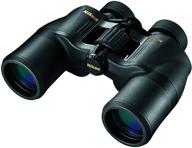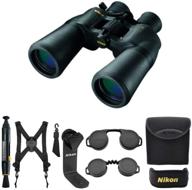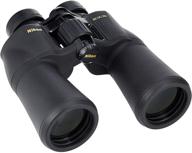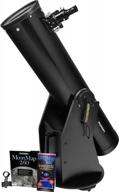
Review on Nikon Aculon A211 7x50 Black by Jnis Staulis ᠌

Excellent quality, absolutely not expected for such a price.
solid, robust build. Like a glove, it rests in the hands. A thin plastic eyepiece bridge marginally detracts from the overall effect at the same time. Weird! The evidence is very strong. Aluminum may have been used to construct the bridge. By the way, in order to minimize effort required for removal and application, the eyepiece covers are held so sluggishly. With the same budget cameras, a cheap Chinese tripod works well. without an adaptor, straight. taken out between pipes. Perhaps more pricey ones will suffice. High-aperture beans do not induce blindness in strong light because the exit pupil is substantially larger than the constricting pupil of the eye. But the heightened brightness is particularly perceptible at night. The image is crisp, there isn't much tremor, and I failed to notice the difference in the optical axes. It's true that there appeared to be too many chromatic aberrations, but for a class with such a large aperture, this is actually rather typical. The weather prevents you from viewing the starry sky, though. After all, it was purchased as an astronomical one as well. Such a tool is essential for learning the sky for inexperienced observers. Microreport: March. 60 000 inhabitants, moderate exposure, and private sector. Milky Way ne'er. Ch. not observable. The little bucket is a terrible idea. Binoculars quickly identify M37, M36, and M38; Yupak can see all Galilean satellites from his hands aside from Io. Io shows up holding a tripod. The galaxy M51 was discovered with little difficulty. I'm also searching diligently for M101; there is a suggestion, but it might just be in my head. You must lie down on the crust so close to the zenith that it is uncomfortable. And now a problem surfaces: if you press the eyepieces on your face, defocusing happens—a flimsy bridge! * April's end. Finally, the nighttime illumination started to go out and everything at least a little "brightened" (in the sense of "dark"). There were the galaxies M94, M63, M106, and of course, the well-known M101. The list of "light" deep skys doesn't end here. We'll wait for further darkness with our astronomical (read: "normal") clamshell at the ready. * August. M33 was eventually made visible! looking forward to the winter and late autumn.
- 1. A sturdy design. 2. You can use a cheap tripod.
- 1. An excessive chromatization. 2. The ocular bridge is weak.
New products
Comments (1)













